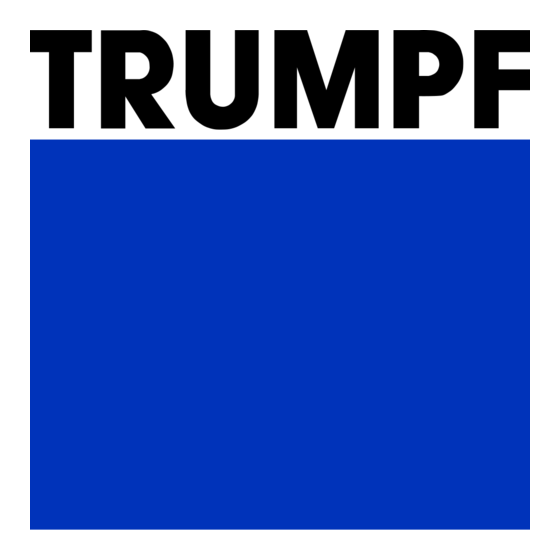
Summarization of Contents
Chapter 1 Safety
1 For your safety
Guidance on general safety practices and regulations.
2 Operational safety
Rules and guidelines for safe operation of the machine.
2.1 Intended use
Specifies authorized applications and limitations of the machine.
2.2 Authorized personnel
Defines qualifications for operating and maintaining the machine.
3 Hazards
Identifies potential dangers and risks associated with machine operation.
3.1 Dangers due to the open electrical cabinet
Risks associated with accessing the electrical cabinet.
3.2 Hazards due to laser radiation
Dangers related to laser beams emitted by the machine.
3.3 Dangers handling workpieces
Risks associated with manipulating workpieces during operations.
Sharp-edged workpieces
Hazards from sharp edges on workpieces.
Upper and lower tool
Risks involving the machine's upper and lower tools.
Flange of the workpiece
Hazards related to workpiece flanges during bending.
Positioning the workpiece
Risks during the placement of workpieces.
Falling workpieces
Hazards from workpieces falling.
Improper handling of flat workpieces
Dangers from incorrect handling of flat workpieces.
Improper handling when bending boxes
Risks from improper bending of box-shaped workpieces.
3.4 Dangers due to unexpected movements
Risks from unintended machine movements.
3.5 Noise hazards
Dangers from noise exposure during operation.
4 Measures to be taken by the manufacturer
Safety features and responsibilities of the manufacturer.
4.1 Danger zones and safeguarding device
Identification of danger zones and safety equipment.
4.2 Safety-relevant signs on the machine
Explains warning and safety signs on the machine.
4.3 Safety-relevant signs on the machine (USA and Canada)
Specific safety signs for US and Canadian markets.
5 Organizational measures to be taken by the user
User responsibilities for safe operation and maintenance.
5.1 Observe warnings and warning signs
Importance of heeding all warnings and signs.
5.2 Training and instructing operators
Requirements for operator training and instruction.
5.3 Adhering to the duty of care when handling the machine
User's responsibility for safe machine handling.
5.4 Water protection
Guidelines for preventing water contamination.
5.5 Spare parts, accessories, software, operating materials
Rules for using approved parts and materials.
5.6 Safety data sheet on hazardous materials
Information on accessing safety data sheets for materials.
6 Overview of residual risks
Summary of remaining risks after safety measures.
7 Disassembly and disposal
Procedures for safely dismantling and disposing of the machine.
Chapter 2 Installation Conditions
1 Planning aid
Overview of measures and preparations for installation.
2 Installation site
Requirements for the physical location of the machine.
2.1 Space requirements
Dimensions needed for machine installation and operation.
2.2 Floor requirements
Specifications for the floor where the machine will be placed.
Surface
Requirements for the machine's surface.
Flatness
Tolerance limits for floor flatness.
2.3 Weight load
Information on machine weight and load distribution.
2.4 Stress due to vibration
How external vibration affects machine operation.
2.5 Ambient conditions
Environmental factors affecting machine performance.
3 Electrics
Electrical connection requirements and specifications.
3.1 Power supply
Details on the main power connection.
3.2 Power supply systems
Information on UPS, RCD, and power configurations.
3.3 Network link
Connection details for the machine's network interface.
4 Operating materials
Information on fluids and materials used with the machine.
4.1 Hydraulic oil
Specifications and handling of hydraulic oil.
5 Preparation for commissioning
Steps required before machine startup by service.
6 Transport
Procedures and guidelines for moving the machine.
6.1 Preparing transport
Checks and preparations before transporting the machine.
6.2 Permitted auxiliary tools
Approved equipment for machine transport.
6.3 Checking, unloading and transporting the machine
Steps for receiving and moving the machine.
6.4 Relocating the machine
Procedures for moving the machine after initial installation.
7 Installation
Steps for physically installing the machine.
7.1 Positioning the machine and drilling holes
Aligning the machine and preparing anchor points.
8 Set-up and positioning
Adjusting machine legs and final positioning.
8.1 Preparing adjustable legs, positioning the machine
Adjusting leveling feet and securing the machine.
9 Support bracket
Instructions for assembling support brackets.
9.1 Assemble the support bracket
Steps to install the provided support brackets.
10 Foot switch and network cable
Connecting the foot switch and network interface.
10.1 Connect the foot switch and network cable
Detailed steps for connecting cables.
11 Electrical connection
Finalizing the machine's electrical hookup.
11.1 Connecting the power cable
Steps for connecting the main power cable.
















Need help?
Do you have a question about the TruBend 2100 and is the answer not in the manual?
Questions and answers